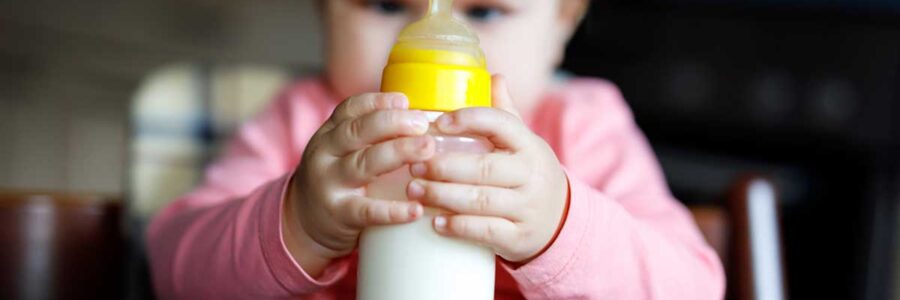In the world of parenting, the well-being of our infants is the linchpin around which all decisions pivot. From their nutrition to their playthings, ensuring a secure setting for our little ones is our utmost concern. Yet, a recent scientific discourse has cast doubts on a ubiquitous childcare instrument: plastic baby bottles. This article delves into the concerning evidence that has emerged, highlighting the significant discharge of microplastics from these bottles, which poses serious Plastic Bottle Risks.
The Startling Discovery
Plastic baby bottles have been a cornerstone in homes across the globe for years, valued for their resilience and handiness. However, recent scientific advancements have prompted a critical reevaluation. Studies have shown that heating breast milk or formula in polypropylene plastic bottles, a common practice among many families— releases millions of microplastics. Astonishingly, this can amount to up to 16.2 million microplastic particles per liter of baby formula.[1] This revelation marks a drastic departure from prior beliefs about the safety of plastic bottles, underscoring the urgent need for dialogue regarding the materials we use for infant feeding.
The Microplastic Menace
Microplastics, defined as plastic fragments less than five millimeters in size, can arise from various sources, including the breakdown of larger plastic items and synthetic textiles. Particularly in baby bottles, these particles are released in greater quantities upon heating, a routine step for many parents in milk preparation. The ramifications of this finding are significant. Though in-depth research on the exact impact of microplastics on human health is ongoing, existing animal studies associate microplastics with severe health issues, such as brain damage and gastrointestinal disorders.[2-4] While these findings are not directly applicable to humans, they highlight the potential dangers of microplastic exposure, especially for infants.
Implications for Human Health
The primary concern regarding microplastics is the uncertainty of their effects on human health. While animal research offers crucial insights, the direct implications for humans, particularly infants, remain largely uncharted. However, the principle of caution advises us to take these findings seriously. Adding to these apprehensions, recent studies have shown that infants have a higher concentration of microplastics in their feces compared to adults,[5] a distressing fact considering the vulnerability of infants whose physiological and immune systems are in developmental stages. The incomplete knowledge of microplastics’ potential health risks underscores the importance of caution in protecting our children’s health.
Seeking Safer Alternatives
Given these concerns, it is vital for parents to seek safer alternatives to plastic baby bottles. A fundamental measure is to avoid warming breast milk or formula in plastic vessels. We can markedly reduce exposure by eliminating heat, a key catalyst for microplastic release. Alternatives such as glass bottles, which have been used safely for generations, provide a non-toxic and environmentally friendly option. They do not leach harmful chemicals or microplastics when heated, ensuring the purity and safety of the infant’s milk. Other materials like stainless steel or silicone are also emerging as popular, safe, and durable options for infant feeding.
Debunking the Myth of BPA and BPS-Free Plastics
A widespread misconception is that plastics devoid of BPA and BPS are safer alternatives to Plastic Bottle Risks. Although these plastics lack certain hazardous chemicals, they do not prevent the release of microplastics.[6] Microplastics are intrinsic to all plastics, not just those containing specific chemicals like BPA or BPS. Therefore, opting for BPA or BPS-free bottles does not eliminate the risk of microplastic contamination. This misconception diverts focus from the broader issue of plastic safety, emphasizing the need for a holistic approach in selecting baby feeding bottles.
Conclusion
The revelation of Plastic Bottle Risks, including microplastics in plastic baby bottles, has brought a pressing concern to light for parents Although the complete health effects of microplastics on infants are yet to be fully understood, the existing evidence warrants caution. It serves as a reminder that as parents and caregivers, we must remain vigilant and adaptable to new research, especially concerning the health and safety of our children. By opting for safer alternatives and staying abreast of scientific findings, we can make informed decisions for our infants, ensuring their environment is as secure and healthful as possible.
References:
- Li, Dunzhu et al. “Microplastic Release from the degradation of polypropylene feeding bottles during infant formula preparation.” Nature food vol. 1,11 (2020): 746-754. doi:10.1038/s43016-020-00171-y
- Lee, Yongjin et al. “Health Effects of Microplastic Exposures: Current Issues and Perspectives in South Korea.” Yonsei Medical Journal vol. 64,5 (2023): 301-308. doi:10.3349/ymj.2023.0048
- Campanale, Claudia et al. “A Detailed Review Study on Potential Effects of Microplastics and Additives of Concern on Human Health.” International Journal of Environmental Research and Public Health vol. 17,4 1212. 13 Feb. 2020, doi:10.3390/ijerph17041212
- Amran, Nur Hanisah et al. “Exposure to Microplastics during Early Developmental Stage: Review of Current Evidence.” Toxics vol. 10,10 597. 10 Oct. 2022, doi:10.3390/toxics10100597
- Sripada, Kam et al. “A Children’s Health Perspective on Nano- and Microplastics.” Environmental Health Perspectives vol. 130,1 (2022): 15001. doi:10.1289/EHP9086
- Thoene, Michael et al. “Bisphenol S in Food Causes Hormonal and Obesogenic Effects Comparable to or Worse than Bisphenol A: A Literature Review.” Nutrients vol. 12,2 532. 19 Feb. 2020, doi:10.3390/nu12020532


